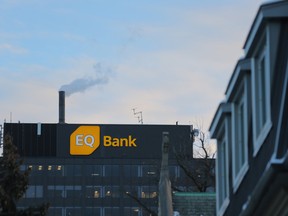Article content
Challenger bank EQB Inc. is expecting growth in conventional loan originations to moderate over the rest of the year as a real estate slowdown weighs on demand.

‘Clearly, homebuyers are sitting on the sidelines a little bit more’
Challenger bank EQB Inc. is expecting growth in conventional loan originations to moderate over the rest of the year as a real estate slowdown weighs on demand.
In an interview on Wednesday, chief executive Andrew Moor said Equitable Bank — the company’s schedule I bank — has seen some slowing in activity in terms of new mortgage applications, but that that was to be expected with rapidly rising interest rates.
“Clearly, homebuyers are sitting on the sidelines a little bit more,” Moor said, adding that the bank saw weaker results in Ontario, which makes up more than half of its business, while provinces in the west were stronger.
EQB, formerly Equitable Group Inc., nevertheless maintained its full-year guidance for 2022, expressing confidence in meeting its objectives despite sector volatility.
The bank added that it has taken “risk-managed actions” over the first two quarters, which Moor said include being more cautious in areas further from city centres.
“We’ve been just trimming back a little bit in our risk appetite in some of those areas,” he said.
EQB said it also continued to proactively adjust its underwriting approach to respond to elevated risks from inflation, the Bank of Canada’s response to inflation and its expectations of changing collateral values.
This is a tough quarter report
Andrew Moor
Although still expecting EQB to deliver on its growth targets, some analysts are taking a cautious stance on the mortgage finance sector as risk remains elevated.
“Several factors represent downside risks that will continue to constrain sector valuations and share price performance near term, such as rising regulatory and policy uncertainty, rapid rise in interest rates, and housing market risk,” said Jaeme Gloyn, an analyst at National Bank of Canada Financial Inc., in a note to clients.
Gloyn cut his estimated target price to $73 per share from $75, while maintaining an “outperform” rating on the stock.
EQB reported strong performance on quarterly net interest income on Tuesday with an all-time record of 15.6 per cent return on equity for the year-to-date period. Conventional lending growth in its core operations grew 36 per cent, year over year.
However, Equitable said severe capital market volatility led to mark-to-market losses of $8.7 million on its non-interest income investment portfolio, which it said was conceived so Equitable Bank can gain access to early-stage technologies.




Moor said the bank is “very much fintech-enabled” and they’ve invested in some of the leading fintechs in Canada, including Borrowell and Wealthsimple.
“This is a tough quarter report. Despite taking a by-the-book approach to achieve and ultimately deliver strong core earnings growth, our efforts put in Q2 are offset by mark-to-market declines primarily in our strategic investment portfolios due to a downdraft in North American equity markets,” Moor said during Wednesday’s earnings call.
EQB said it expects volatility to continue in the second half of 2022, but this does not reflect the underlying strategic value of these investments.
The bank’s adjusted diluted earnings per share for the three months ended June 30 were $1.75, down from $2.64 a year ago.
For the current quarter, Moor said EQB is prioritizing its introduction of EQ Bank’s payment card, the launch of EQ Bank in Québec and its acquisition of Concentra Bank, which is expected to close later in the year.
• Email: dpaglinawan@postmedia.com | Twitter:


|
|
KUALA LUMPUR: A meeting with 70 financial fund investors and corporate members at the recently concluded Joint Investors Meeting in London has touched on the MADANI government’s immediate action to stimulate strategic investment in important technologies, according to the Ministry of Finance (MoF).
In a statement today, it said that the government is serious about making investments a national agenda through the establishment of a high-level investment facilitation platform to ensure the implementation of potential and approved strategic investments through a “Whole of Government” approach.
Minister of Finance II Datuk Seri Amir Hamzah Azizan (pix), who led the Malaysian delegation to the Joint Investors Meeting from April 20 to 22, said that the National Investment Council (MPN) chaired by the Prime Minister is an integrated action that reflects how serious the government is in making Malaysia an investment hub in the region.
Among the immediate actions taken by the government is establishing the National Semiconductor Strategic Committee (NSSTF) to facilitate cooperation between the government, industry players, universities, and relevant stakeholders to place the Malaysian semiconductor industry at the forefront and ensure the continued growth of the electronics & electrical industry, especially the semiconductor sector, as a major contributor to the Malaysian economy.
The government also aims to empower Malaysia as a preferred green investment destination as well as remove barriers and bureaucracy in the provision and accessibility to renewable energy, especially for the new technology industry, including data centres, said Amir Hamzah.
He also said that the country’s investment prospects have reached an extraordinary level, with approved investments surging to RM329.5 billion in 2023 from RM268 billion in 2022.
He said about 74 per cent of manufacturing projects approved between 2021 and 2023 have been completed or are in process.
In addition, Amir Hamzah said the greater initial stage construction work completed in 2023 (RM31.5 billion) and 2022 (RM26.3 billion) shows a positive trend for future investment opportunities.
“From a total of 5,101 investment projects approved in 2023, as many as 81.2 per cent or 4,143 projects are in the services sector, 883 projects in the manufacturing sector, and 75 projects in other related sectors,” he said.
Before this, Amir Hamzah met with international investors in New York and Washington to clarify the direction of the implementation of the MADANI Economic framework to improve investors’ confidence in Malaysia’s economic level and strengthen the perception and investment sentiment of foreign investors towards the country.







|
|
Compound interest is a thing of magic. It’s also one of your best bets if you’re looking to retire rich.
It might take time and patience but there’s not a whole lot of heavy lifting when it comes to a buy-and-hold investment strategy. What matters most is having decades of time in front of you, which will allow you to maximize the benefits of compounded returns. And, of course, choosing the right investments is equally important.
With a decent return, building a million-dollar portfolio might not be as hard as you think. An initial investment of $15,000, returning 15% annually, would be worth just shy of $1 million in 30 years.
First off, 30 years is a long time, which means you’ll need to be planning your retirement far in advance. However, all it takes is one initial investment of $15,000 and the right stocks to build a $1 million portfolio.
Additionally, it’s important to remain realistic and acknowledge that a stock returning 15% annually is not exactly common. That being said, the TSX certainly has its share of dependable companies with track records of returning far more than just 15% per year.
I’ve put together a list of three Canadian stocks that are perfect for hands-off investors who are looking to retire rich.
It will require a steep initial investment, but Constellation Software (TSX:CSU) is well worth its nearly $4,000-a-share price tag. When it comes to market-crushing returns, the tech stock has been in a league of its own over the past two decades.
Even as the company is now valued at a massive market cap of close to $80 billion, the impressive returns have continued. Shares are up more than 200% over the past five years. That’s good enough for a compound annual growth rate (CAGR) of 25%.
At a 25% annual return, a $15,000 investment would be worth a whopping $12 million in 30 years.
Descartes Systems (TSX:DSG) is another tech stock that’s no stranger to delivering market-beating returns. The company is also only valued at a market cap of $10 billion, leaving plenty of room for growth in the coming decades.
There’s a reason why Descartes Systems is one of the few tech stocks trading near all-time highs today. This stock is a proven winner, with lots of growth left in the tank.
Over the past five years, the stock has had a CAGR just shy of 20%.
The last pick on my list is a beaten-down growth stock that’s trading at a serious discount.
The consumer-facing financial services provider has been hit by short-term headwinds from sky-high interest rates. With potential rate cuts around the corner though, now could be an excellent time to be loading up on goeasy (TSX:GSY).
Even with shares down 25% from all-time highs, the stock is still nearing a return of 300% over the past five years.
goeasy was crushing the market’s returns before the recent spike in interest rates, and there’s no reason to believe why the company won’t continue to do so for years to come.





|
|
TORONTO, April 24, 2024 /CNW/ – Flagship Communities Real Estate Investment Trust (the “REIT” or “Flagship“) (TSX: MHC.U) (TSX: MHC.UN) announced today that it has completed its previously announced public offering (the “Offering“) of 3,910,000 trust units (the “Units“) on a bought deal basis at a price of US$15.35 per Unit for total gross proceeds to the REIT of approximately US$60 million.
The Offering was completed through a syndicate of underwriters co-led by BMO Capital Markets and Canaccord Genuity Corp.
ADVERTISEMENT
The REIT intends to use the net proceeds from the Offering to fund a portion of the approximately US$93 million aggregate purchase price for the REIT’s previously announced acquisition of seven manufactured housing communities comprising 1,253 lots (the “Acquisitions“) and for general business purposes. In the event the REIT is unable to consummate one or both of the Acquisitions, the REIT intends to use the net proceeds of the Offering to fund future acquisitions and for general business purposes.
The REIT has also granted the underwriters an over-allotment option to purchase up to an additional 586,500 Units on the same terms and conditions, exercisable at any time, in whole or in part, up to 30 days after the date hereof.
About Flagship Communities Real Estate Investment Trust
Flagship Communities Real Estate Investment Trust is a leading operator of affordable residential Manufactured Housing Communities primarily serving working families seeking affordable home ownership. The REIT owns and operates exceptional residential living experiences and investment opportunities in family-oriented communities in Kentucky, Indiana, Ohio, Tennessee, Arkansas, Missouri, and Illinois. To learn more about Flagship, visit www.flagshipcommunities.com.
Forward-Looking Statements
This press release contains statements that include forward-looking information (within the meaning of applicable Canadian securities laws). Forward-looking statements are identified by words such as “believe”, “anticipate”, “project”, “expect”, “intend”, “plan”, “will”, “may”, “can”, “could”, “would”, “must”, “estimate”, “target”, “objective”, and other similar expressions, or negative versions thereof, and include statements herein concerning the use of the net proceeds of the Offering.
These forward-looking statements are based on the REIT’s expectations, estimates, forecasts and projections, as well as assumptions that are inherently subject to significant business, economic and competitive uncertainties and contingencies that could cause actual results to differ materially from those that are disclosed in such forward-looking statements. While considered reasonable by management of the REIT as at the date of this news release, any of these expectations, estimates, forecasts, projections, or assumptions could prove to be inaccurate, and as a result, the forward-looking statements based on those expectations, estimates, forecasts, projections, or assumptions could be incorrect. Material factors and assumptions used by management of the REIT to develop the forward-looking information in this news release include, but are not limited to, that the conditions to closing of the Acquisitions will be met or waived in a timely manner and that both of the Acquisitions will be completed on the current agreed upon terms.
When relying on forward-looking statements to make decisions, the REIT cautions readers not to place undue reliance on these statements, as they are not guarantees of future performance and involve risks and uncertainties that are difficult to control or predict. A number of factors, many of which are beyond the REIT’s control, could cause actual results to differ materially from the results discussed in the forward-looking statements, such as the risks identified in the REIT’s management’s discussion and analysis for the year ended December 31, 2023 available on the REIT’s profile on SEDAR+ at www.sedarplus.com, including, but not limited to, the factors discussed under the heading “Risks and Uncertainties” therein and the risk of the REIT’s plans with respect to debt bridge financing for the Acquisitions not being achieved as anticipated. There can be no assurance that forward-looking statements will prove to be accurate as actual outcomes and results may differ materially from those expressed in these forward-looking statements. Readers, therefore, should not place undue reliance on any such forward-looking statements. Forward-looking statements are made as of the date of this press release and, except as expressly required by applicable Canadian securities laws, the REIT assumes no obligation to publicly update or revise any forward-looking statement, whether as a result of new information, future events or otherwise.









Remnants of bird flu virus found in pasteurized milk, FDA says
Amid concerns over ‘collateral damage’ Trudeau, Freeland defend capital gains tax change
Random: We’re In Awe of Metaphor: ReFantazio’s Box Art
The unmissable events taking place during London’s Digital Art Week
Surprise Apple Event Hints at First New iPads in Years




How Michael Cohen and Trump went from friends to foes
NASA hears from Voyager 1, the most distant spacecraft from Earth, after months of quiet




Exploring ecological networks in a digital world | News | Vancouver Island University | Canada